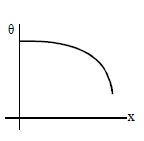A long metallic bar is carrying heat from one of its ends to the other end under steady-state. The variation of temperature $\theta$ along the length $x$ of the bar from its hot end is best described by which of the following figures ?
A long metallic bar is carrying heat from one of its ends to the other end under steady-state. The variation of temperature $\theta$ along the length $x$ of the bar from its hot end is best described by which of the following figures ?
- A

- B

- C

- D

Similar Questions
Assuming the sun to be a spherical body of radius $R$ at a temperature of $TK$ , evaluate the total radiant power, incident on the earth, at a distance $r$ from the sun, is (Where $r_0$ is the radius of the earth and $\sigma $ is Stefan s constant.)
Assuming the sun to be a spherical body of radius $R$ at a temperature of $TK$ , evaluate the total radiant power, incident on the earth, at a distance $r$ from the sun, is (Where $r_0$ is the radius of the earth and $\sigma $ is Stefan s constant.)
A body cools in a surrounding which is at a constant temperature of $\theta _0$ . Assuming that it obeys Newton's law of cooling, its temperature $\theta $ is plotted against time $t$ . Tangents are drawn to the curve at the points $A(\theta = \theta _1)$ and $B(\theta = \theta _2)$ . These tangents meet the time-axis at angles $\alpha _1$ and $\alpha _2$ as shown in the graph then
A body cools in a surrounding which is at a constant temperature of $\theta _0$ . Assuming that it obeys Newton's law of cooling, its temperature $\theta $ is plotted against time $t$ . Tangents are drawn to the curve at the points $A(\theta = \theta _1)$ and $B(\theta = \theta _2)$ . These tangents meet the time-axis at angles $\alpha _1$ and $\alpha _2$ as shown in the graph then
Two metal wires of identical dimensions are connected in series. If $\sigma _1$ and $\sigma _2$ are the conductivities of the metal wires respectively, the effective conductivity of the combination is
Two metal wires of identical dimensions are connected in series. If $\sigma _1$ and $\sigma _2$ are the conductivities of the metal wires respectively, the effective conductivity of the combination is
Six wires each of cross-sectional area $A$ and length $l$ are combined as shown in the figure. The thermal conductivities of copper and iron are $K_1$ and $K_2$ respectively. The equivalent thermal resistance between points $A$ and $C$ is
Six wires each of cross-sectional area $A$ and length $l$ are combined as shown in the figure. The thermal conductivities of copper and iron are $K_1$ and $K_2$ respectively. The equivalent thermal resistance between points $A$ and $C$ is
Assuming newton's law of cooling to be valid, body at temperature $50^o\ C$ in surrounding of temperature $20^o\ C$ , achieve steady state with help of $100\ W$ heater. If same body has temperature $35^o\ C$ in same surrounding, then power of heater required to maintain steady state ........ $W$
Assuming newton's law of cooling to be valid, body at temperature $50^o\ C$ in surrounding of temperature $20^o\ C$ , achieve steady state with help of $100\ W$ heater. If same body has temperature $35^o\ C$ in same surrounding, then power of heater required to maintain steady state ........ $W$
